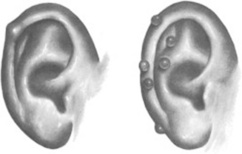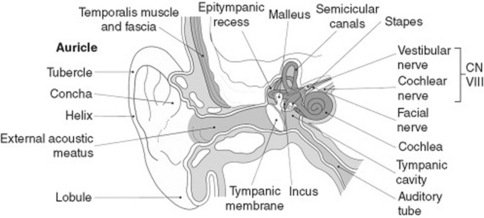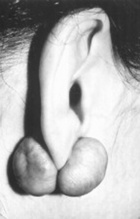Chapter 5 The Ear
René Théophile Hyacinthe Laennec, 1821; letter to his cousin Menadec
St. John Baptiste de la Salle (1651–1719), The Rules of Christian Manners and Civility, I
A. External Ear
6 What is the auricle (or pinna)?
It is the part of the external ear that is outside the canal (Fig. 5-1). Made of cartilage and skin, it is highly flexible.
7 What are auricular bumps? What causes them?
 Darwin’s tubercle (Fig. 5-2): Benign and congenital nodule near the auricular apex (on the helix, at the junction of upper and middle thirds). Nontender and rarely bilateral, it was first described by the British sculptor Thomas Woolner, a founding member of the Pre-Raphaelite Brotherhood and a spare-time anatomist. Woolner depicted it in his statue of “Puck,” and Charles Darwin was so impressed that he named it the Woolnerian tip. It is an atavistic feature (i.e., a trait typical of our mammalian ancestors—more specifically, monkeys).
Darwin’s tubercle (Fig. 5-2): Benign and congenital nodule near the auricular apex (on the helix, at the junction of upper and middle thirds). Nontender and rarely bilateral, it was first described by the British sculptor Thomas Woolner, a founding member of the Pre-Raphaelite Brotherhood and a spare-time anatomist. Woolner depicted it in his statue of “Puck,” and Charles Darwin was so impressed that he named it the Woolnerian tip. It is an atavistic feature (i.e., a trait typical of our mammalian ancestors—more specifically, monkeys).
 Keloids (Fig. 5-3): Smooth and flesh-colored papule(s) on one or both sides of the earlobe. They indicate an exuberant and fibrotic response to injury.
Keloids (Fig. 5-3): Smooth and flesh-colored papule(s) on one or both sides of the earlobe. They indicate an exuberant and fibrotic response to injury.
 Tophi: One or more nontender nodules on the auricular edges. They are named after the Latin tufa (a calcareous and volcanic deposit) and may indeed be mildly hard. They can occur on both helix and antihelix, and usually indicate hyperuricemia and gout.
Tophi: One or more nontender nodules on the auricular edges. They are named after the Latin tufa (a calcareous and volcanic deposit) and may indeed be mildly hard. They can occur on both helix and antihelix, and usually indicate hyperuricemia and gout.
 Chondrodermatitis nodularis chronica helicis (CNH): This is a common, benign, and painful condition of the most prominent projection of the ear, usually the apex of the helix, but it also may affect the antihelix. It is typical of the right ear of middle-aged to older men, usually fair-skinned individuals with cutaneous sun-damage. In 10–35% of cases, it may also affect women. It is rather common (in a series, the most frequent external ear condition seen in an ear-nose-throat clinic) and is probably due to prolonged and excessive pressure, leading to inflammation, edema, and ischemic necrosis. This eventually degenerates into secondary perichondritis due to the vascular characteristics of the ear. Onset may be precipitated by pressure, trauma, or cold. Sleeping on the affected side is also common. The nodule appears spontaneously and painfully, rapidly enlarging to a maximum size of 4–8 mm, after which it remains stable. It is firm, tender, skin-colored, sharply demarcated, and round to oval in shape. The edge is usually raised, with a central ulcer or crust. It is not associated with systemic disorders.
Chondrodermatitis nodularis chronica helicis (CNH): This is a common, benign, and painful condition of the most prominent projection of the ear, usually the apex of the helix, but it also may affect the antihelix. It is typical of the right ear of middle-aged to older men, usually fair-skinned individuals with cutaneous sun-damage. In 10–35% of cases, it may also affect women. It is rather common (in a series, the most frequent external ear condition seen in an ear-nose-throat clinic) and is probably due to prolonged and excessive pressure, leading to inflammation, edema, and ischemic necrosis. This eventually degenerates into secondary perichondritis due to the vascular characteristics of the ear. Onset may be precipitated by pressure, trauma, or cold. Sleeping on the affected side is also common. The nodule appears spontaneously and painfully, rapidly enlarging to a maximum size of 4–8 mm, after which it remains stable. It is firm, tender, skin-colored, sharply demarcated, and round to oval in shape. The edge is usually raised, with a central ulcer or crust. It is not associated with systemic disorders.

Figure 5-2 Darwin’s tubercle (left) and tophi (right).
(From Seidel HM, Ball JW, Daims JE, Benedict GW: Mosby’s Guide to Physical Examination, 3rd ed. St. Louis, Mosby, 1995.)
16 What is the value of pushing over the mastoid process?
Tenderness suggests suppurative mastoiditis—an ominous complication of ear infections.
19 What may induce vesicles in the auricle?
Not too many causes: (1) severe contact dermatitis (such as poison ivy); (2) varicella/zoster; and (3) Ramsay Hunt syndrome (painful and vesicular rash of the inferior portion of the auricle, due to herpetic infection of the geniculate ganglion and treated with acyclovir. See questions 48 and 49).
20 What are the causes of auricular red spots?
 Trauma: This also may result in auricular ecchymoses and even hematomas (see question 22).
Trauma: This also may result in auricular ecchymoses and even hematomas (see question 22).
 Port wine stain: Usually congenital and of only cosmetic importance. One of the most famous port wine stains in history was on the forehead of Soviet President Michail Gorbachev.
Port wine stain: Usually congenital and of only cosmetic importance. One of the most famous port wine stains in history was on the forehead of Soviet President Michail Gorbachev.
 Sturge-Weber disease: Port wine nevus on the upper part of the scalp, associated with intracranial vascular abnormalities that may cause cerebellar calcifications and seizures.
Sturge-Weber disease: Port wine nevus on the upper part of the scalp, associated with intracranial vascular abnormalities that may cause cerebellar calcifications and seizures.
22 What is a tender and swollen auricle?
It is an uncommon but dramatic event. A diffusely swollen auricle is usually due to:
 Trauma: Easily identifiably by a history of recent altercation, especially if supported by other evidence of trauma, like a broken nose or a black eye. In fact, a “cauliflower” ear auricle is a time-honored occupational hazard of boxers, first portrayed in a beautiful Hellenistic statue of a resting fighter (Fig. 5-4). Unless evacuated, auricular hematomas heal with fibrosis and deformity and may even result in hearing loss. For instance, it has been suggested that Edison’s deafness was the result of having been picked up by the ears as a child. Still, there is no evidence that he had a cauliflower ear. President Johnson, on the other hand, contributed to our advance in veterinary medicine by demonstrating that cauliflower ears do not occur in dogs, especially beagles. In fact, he used to pick up his pooch by the ears and then toss him around in front of the press corps. LBJ, however, had no ear problems we know of, with the possible exception of selective deafness to war protesters in nearby Lafayette Park.
Trauma: Easily identifiably by a history of recent altercation, especially if supported by other evidence of trauma, like a broken nose or a black eye. In fact, a “cauliflower” ear auricle is a time-honored occupational hazard of boxers, first portrayed in a beautiful Hellenistic statue of a resting fighter (Fig. 5-4). Unless evacuated, auricular hematomas heal with fibrosis and deformity and may even result in hearing loss. For instance, it has been suggested that Edison’s deafness was the result of having been picked up by the ears as a child. Still, there is no evidence that he had a cauliflower ear. President Johnson, on the other hand, contributed to our advance in veterinary medicine by demonstrating that cauliflower ears do not occur in dogs, especially beagles. In fact, he used to pick up his pooch by the ears and then toss him around in front of the press corps. LBJ, however, had no ear problems we know of, with the possible exception of selective deafness to war protesters in nearby Lafayette Park.
 Relapsing polychondritis: May affect all facial cartilages, including the alar of the nose and the auricular of the ear(s).
Relapsing polychondritis: May affect all facial cartilages, including the alar of the nose and the auricular of the ear(s).
Stay updated, free articles. Join our Telegram channel

Full access? Get Clinical Tree












